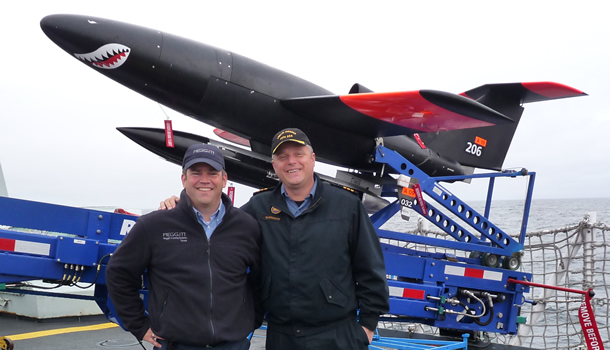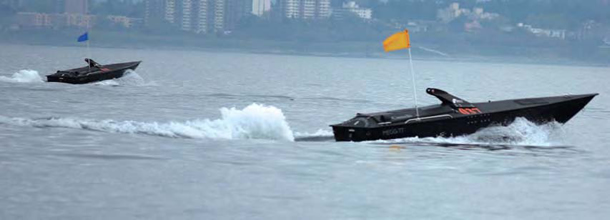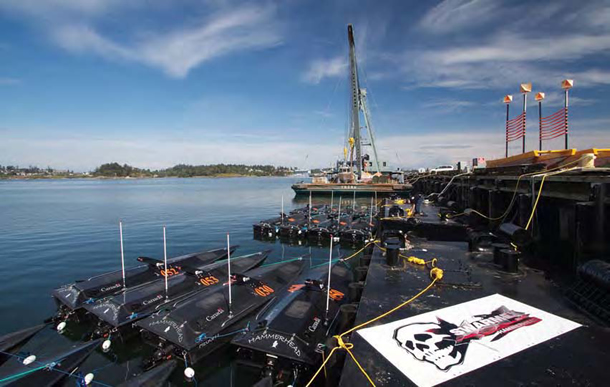Dull, Dirty & Dangerous?

Victoria claims to be one of the sunniest cities in British Columbia, but on a foggy morning in May 2010, it wasn’t living up to its billing. Instead, the coastal area west of the city, normally home to crab pot fishing boats was the exclusive preserve of a Canadian naval frigate, HMCS Winnipeg, out of CFB Esquimalt. Interrupting the early morning silence was the buzzing sound of a swarm of water-born drones bearing down on the frigate.
Spencer Fraser, President and General Manager of Meggitt Training Systems Canada, was in a control room on shore, watching the drama unfold with the enthusiasm of a boy with a remote-controlled toy boat. But these were hardly toys, and this was no game. It was serious business. Defence business. Spencer and his team of engineers and designers were controlling the contingent of drones simulating an attack on the Winnipeg. Dubbed Swarm-Ex, the exercise had been in the planning stages with Canada’s Department of National Defence for several years. Its objective: to showcase the capabilities of Meggitt’s Hammerhead unmanned surface vehicle (USV), a 17-foot, remote-controlled speedboat—the ultimate moving target for use in naval training exercises. Its size, speed and manoeuvrability simulate swarms of small, fast, attack boats operated by suicide bombers, pirates or others bent on doing harm to larger naval vessels; like the classic tale of Lilliputians holding down Gulliver.
That morning, the good guys masquerading as bad guys won, for the Hammerheads not only passed the test, they set a world record for being the largest number of USVs to be unleashed simultaneously as part of a training exercise. “It was pretty thrilling,” Spencer recalls. “We had a few dramatic moments along the way, like when some uninformed fishermen headed out to check their crab pots in the restricted area.”
It was hardly a typical day at the office, but then Spencer hasn’t had as many desk-bound days as most CEOs. His career began at the age of 17 when he enrolled at the Royal Military College in Kingston. The naval cadet completed his four years of study, met and married his Queen’s sweetheart Anne Rogers (BEd’92) and embarked on a career in the Canadian navy that took him from Halifax to Victoria, changing jobs and locations every two years. He was the first anglophone officer to be posted to an exchange with the French navy at Toulon on the Mediterranean coast. Another European stint followed in 1999, when he was sent to staff college in the UK and concurrently completed a Master’s degree in Defence Studies at King’s College in London. In between packing and moving, Spencer and Anne started a family, welcoming first-born Amy in 1995 and Will in 1998.
A suicide bomber in a speedboat won’t sink a warship, but if he kills sailors and causes horrific damage, he gets his CNN moment.

Spencer’s last posting brought him to the Department of National Defence (DND) Headquarters in Ottawa, in the Directorate of Maritime Requirements (Sea), where he was responsible for various naval equipment procurement efforts.
“I had difficulty in balancing my own chequebook and there I was, a Project Director, in charge of programs budgeted at several hundred million dollars,” he laughs. “I decided after my first encounters with industry that I’d better learn something about business.”
An MBA was a logical choice, and Queen’s was the best fit. “I was impressed with Queen’s program and, of course, its reputation is second to none,” Spencer explains. An MBA would also be an asset after his impending retirement from the military. Though still a young man at 37, he was approaching the 20-year mark, the decision point for staying in or leaving the military.
Meggitt set a world record for the largest number of drones to be unleashed simultaneously in a training exercise.
“I’d thoroughly enjoyed my time as a naval officer, but it seemed like the right time to try something new. Not having to move every two years, which meant Anne had to start anew as a teacher in each city, was a big part of the decision for our family.”
The start of his MBA program coincided with a seismic shift in international security and national defence.
“We were in Julian Barling’s class on September 11, 2001, when the two planes crashed into the World Trade Centre,” Spencer recalls sombrely. “We watched the incredible events unfold on giant TVs set up in the lobby of the Ottawa facility. A year prior, in 2000, the USS Cole, an American warship visiting Yemen, was the subject of a terrorist attack that killed 17 sailors and caused close to a billion dollars in damage. That ushered in the post-cold war emphasis on asymmetric warfare.” This relatively new term is defined as war between belligerents whose relative military power, strategy or tactics differ significantly.
“In naval terms, the most pressing example of asymmetric warfare is the guy who wants to make a political statement,” Fraser explains. “He won’t sink a warship, but if he kills 15 or 20 sailors and causes horrific damage, he gets his CNN moment.”
Back at DND, he and his team recognized that this new type of warfare required a completely new training approach. Large-scale naval manoeuvres, pitting large ship against large ship, had become less likely in the political context of the time. What was needed were opportunities to train crews to defend their ships against attacks from groups of small, fast boats.
Spencer recognized an opportunity to research what other navies were doing in this field and identify a business solution as part of his New Venture Project, an MBA course requirement. He approached Meggitt Training Systems, a manufacturer of defence technologies based in Medicine Hat, Alberta, to develop a proposal for a USV that could be used for this niche training purpose. What started as a New Venture Project eventually launched Meggitt’s design and production of the Hammerhead unmanned surface vehicle.

In 2003, Lieutenant Commander Spencer Fraser retired from the military and looked forward to taking his time in researching his ‘second career’ options. Instead, after reconnecting with his contacts at Meggitt, he was presented with an offer he couldn’t refuse: Join the company and job-shadow the soon-to-retire President before taking over the top role himself. After a family discussion, the decision was made to head west to Medicine Hat, population 60,000. The area is a government designated Centre of Excellence for unmanned vehicle systems development, thanks to its proximity to a Canadian Forces Base training centre and a Defence Research Development Canada centre, both in Suffield.
Spencer currently manages a staff of 75, most located in Medicine Hat and Montreal. Last year, the company posted $20 million in revenues. Its sales of Hammerheads rose from 15 units in 2008 to 50 in 2010, with projections in the 100-unit range this year. While DND had been very supportive of the development of the Hammerhead, it was foreign governments that sought out the system first. Interestingly, it was inaugural export sales to the German and South African governments that helped pave the way for domestic sales. The success of last year’s record-setting Swarm-Ex demonstration further helped build the company’s reputation internationally.
“It’s been an amazing ride so far,” Spencer says. “After a great career in the military, I was looking forward to new challenges, and my role at Meggitt certainly fits the bill. Here I am, working with a great team to help Canadian and foreign navies defend against terrorist threats. It’s important work. The fact that it’s pretty exciting stuff is a bonus.”
